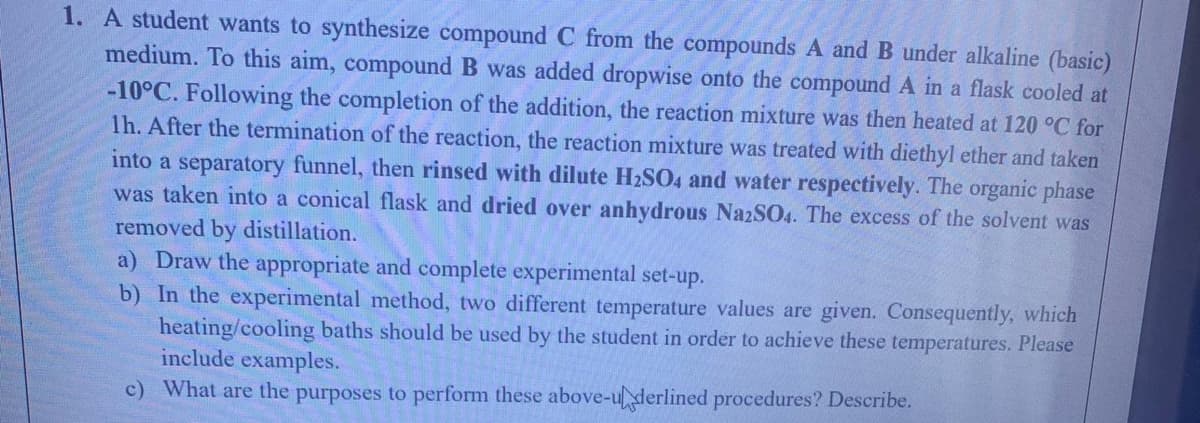1. A student wants to synthesize compound C from the compounds A and B under alkaline (basic) medium. To this aim, compound B was added dropwise onto the compound A in a flask cooled at -10°C. Following the completion of the addition, the reaction mixture was then heated at 120 °C for 1h. After the termination of the reaction, the reaction mixture was treated with diethyl ether and taken into a separatory funnel, then rinsed with dilute H2SO4 and water respectively. The organic phase was taken into a conical flask and dried over anhydrous NazSO4. The excess of the solvent was removed by distillation. a) Draw the appropriate and complete experimental set-up. b) In the experimental method, two different temperature values are given. Consequently, which heating/cooling baths should be used by the student in order to achieve these temperatures. Please include examples. c) What are the purposes to perform these above-uderlined procedures? Describe.
1. A student wants to synthesize compound C from the compounds A and B under alkaline (basic) medium. To this aim, compound B was added dropwise onto the compound A in a flask cooled at -10°C. Following the completion of the addition, the reaction mixture was then heated at 120 °C for 1h. After the termination of the reaction, the reaction mixture was treated with diethyl ether and taken into a separatory funnel, then rinsed with dilute H2SO4 and water respectively. The organic phase was taken into a conical flask and dried over anhydrous NazSO4. The excess of the solvent was removed by distillation. a) Draw the appropriate and complete experimental set-up. b) In the experimental method, two different temperature values are given. Consequently, which heating/cooling baths should be used by the student in order to achieve these temperatures. Please include examples. c) What are the purposes to perform these above-uderlined procedures? Describe.
Chemistry
10th Edition
ISBN:9781305957404
Author:Steven S. Zumdahl, Susan A. Zumdahl, Donald J. DeCoste
Publisher:Steven S. Zumdahl, Susan A. Zumdahl, Donald J. DeCoste
Chapter1: Chemical Foundations
Section: Chapter Questions
Problem 1RQ: Define and explain the differences between the following terms. a. law and theory b. theory and...
Related questions
Question

Transcribed Image Text:1. A student wants to synthesize compound C from the compounds A and B under alkaline (basic)
medium. To this aim, compound B was added dropwise onto the compoundA in a flask cooled at
-10°C. Following the completion of the addition, the reaction mixture was then heated at 120 °C for
1h. After the termination of the reaction, the reaction mixture was treated with diethyl ether and taken
into a separatory funnel, then rinsed with dilute H2SO4 and water respectively. The organic phase
was taken into a conical flask and dried over anhydrous NazSO4. The excess of the solvent was
removed by distillation.
a) Draw the appropriate and complete experimental set-up.
b) In the experimental method, two different temperature values are given. Consequently, which
heating/cooling baths should be used by the student in order to achieve these temperatures. Please
include examples.
c) What are the purposes to perform these above-u derlined procedures? Describe.
Expert Solution
This question has been solved!
Explore an expertly crafted, step-by-step solution for a thorough understanding of key concepts.
Step by step
Solved in 2 steps with 1 images

Knowledge Booster
Learn more about
Need a deep-dive on the concept behind this application? Look no further. Learn more about this topic, chemistry and related others by exploring similar questions and additional content below.Recommended textbooks for you

Chemistry
Chemistry
ISBN:
9781305957404
Author:
Steven S. Zumdahl, Susan A. Zumdahl, Donald J. DeCoste
Publisher:
Cengage Learning

Chemistry
Chemistry
ISBN:
9781259911156
Author:
Raymond Chang Dr., Jason Overby Professor
Publisher:
McGraw-Hill Education

Principles of Instrumental Analysis
Chemistry
ISBN:
9781305577213
Author:
Douglas A. Skoog, F. James Holler, Stanley R. Crouch
Publisher:
Cengage Learning

Chemistry
Chemistry
ISBN:
9781305957404
Author:
Steven S. Zumdahl, Susan A. Zumdahl, Donald J. DeCoste
Publisher:
Cengage Learning

Chemistry
Chemistry
ISBN:
9781259911156
Author:
Raymond Chang Dr., Jason Overby Professor
Publisher:
McGraw-Hill Education

Principles of Instrumental Analysis
Chemistry
ISBN:
9781305577213
Author:
Douglas A. Skoog, F. James Holler, Stanley R. Crouch
Publisher:
Cengage Learning

Organic Chemistry
Chemistry
ISBN:
9780078021558
Author:
Janice Gorzynski Smith Dr.
Publisher:
McGraw-Hill Education

Chemistry: Principles and Reactions
Chemistry
ISBN:
9781305079373
Author:
William L. Masterton, Cecile N. Hurley
Publisher:
Cengage Learning

Elementary Principles of Chemical Processes, Bind…
Chemistry
ISBN:
9781118431221
Author:
Richard M. Felder, Ronald W. Rousseau, Lisa G. Bullard
Publisher:
WILEY